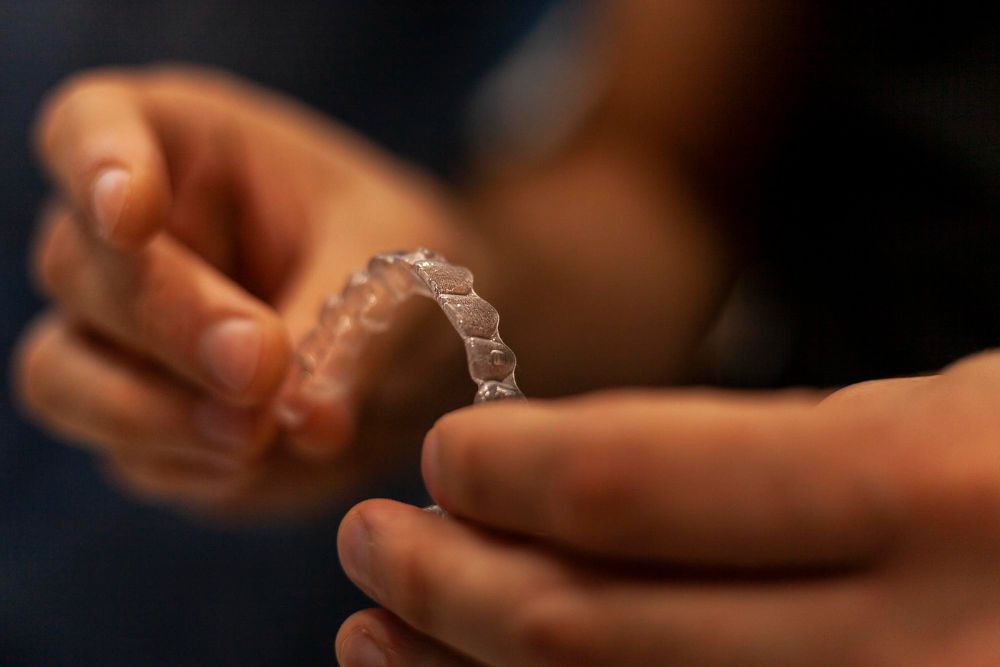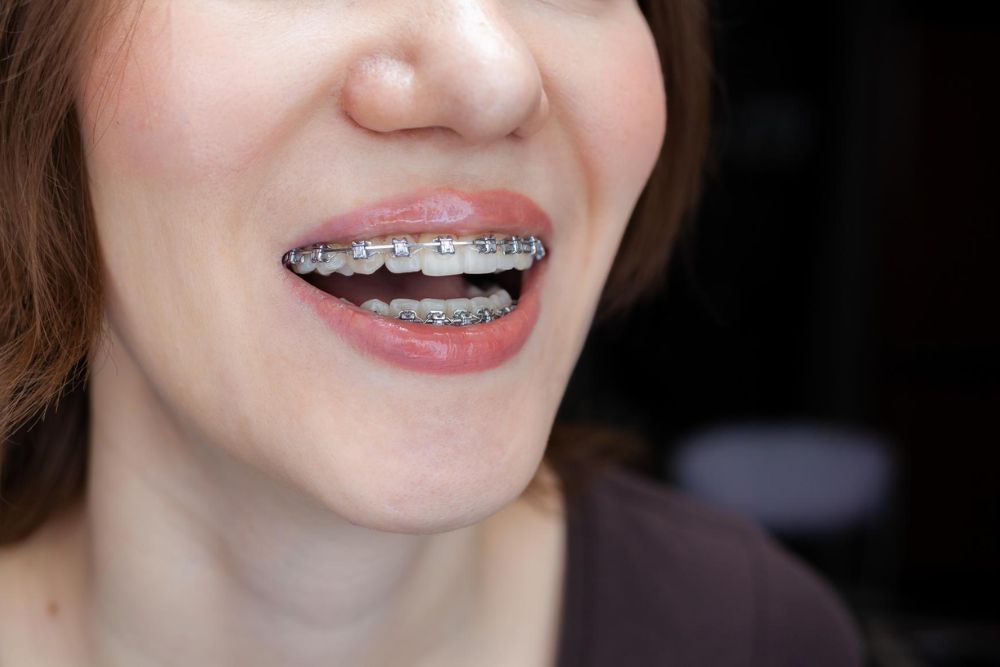Braces and Invisalign are two of the most popular orthodontic treatments for addressing crooked teeth. Both have their pros and cons, so how do you decide which is right for you? Read on as Ashburton Dental Centre discusses the differences between braces and Invisalign so that you can make an informed decision about which treatment is right for you!
What are the Advantages of Invisalign?

Invisalign is a clear aligner system that uses clear plastic trays to straighten crooked teeth.
- Unnoticeable when worn. Because they are made of clear plastic, Invisalign trays are virtually invisible when worn, which is one of the biggest advantages of this treatment option. Most adult patients who are self-conscious about their smile or don’t want to draw attention to their teeth will benefit from Invisalign.
- More comfortable. Another advantage of Invisalign is that it is much more comfortable than braces. Traditional braces have wires or brackets that can cause irritation. In comparison, Invisalign aligners are made of smooth plastic, so they will not rub against your gums or cheeks as metal braces can.
- Can be removed. Invisalign is also removable, so you can take them out to brush or floss your teeth. You can also remove them for special occasions such as weddings or job interviews. This makes them much more comfortable and convenient than braces, which are fixed in place.
- Easier to clean. With metal braces, you have to be careful about what you eat and drink to avoid staining the brackets and wires. With Invisalign, you can remove the aligner trays before eating. You don’t have to worry about food getting stuck in your teeth or damaging your enamel.
- Requires fewer dental visits. Finally, Invisalign is much easier to maintain. Unlike braces that need adjustments at the dentist every month, Invisalign uses a series of clear, removable plastic aligners that adjust your teeth’s alignment over time. The sets of aligners are worn for about two weeks before being replaced with the next set in the series. Scheduling frequent dental visits can be difficult for adult patients with busy schedules, making Invisalign a great choice.
What are the Disadvantages of Invisalign?
While Invisalign may be more comfortable and less visible than traditional braces, they also have some disadvantages:
Can be more expensive. One of the disadvantages of Invisalign is that it can be more expensive than traditional braces. Invisalign orthodontic treatments can range from $3000 to $5000, while traditional braces usually cost between $2000 and $4000. If you are looking for a more affordable treatment option, Invisalign may not be the right choice for you.
Treatment may take longer. Another disadvantage of Invisalign is that the treatment can take longer than traditional braces. While traditional braces usually need to be worn for about one and a half years, Invisalign treatment can take up to two and a half years. This extended treatment time can be frustrating for patients who are looking to get their teeth straightened as quickly as possible.
Needs a higher level of compliance. Invisalign patients must be more proactive about their treatment compared with traditional braces. Patients need to wear their Invisalign aligners for at least 20 – 22 hours a day and must be diligent about cleaning them. If you do not follow these instructions, your treatment can take even longer.
Treatment is not right for everyone. If you have severely misaligned teeth, Invisalign may not be able to correct your teeth as much as traditional braces would. Invisalign is also not recommended for children or teens who are still growing and whose teeth are still developing. If you are considering Invisalign treatment, be sure to consult with a licensed orthodontist to see if it is the ideal treatment option for you.
What are the Advantages of Traditional Braces?

While braces may not be as invisible as Invisalign, they are more effective at correcting complex tooth issues. If you have severe crowding, overbite, underbite, or crooked teeth, braces may be the better option. The other advantages of braces are:
They are more affordable. One of the biggest benefits of traditional braces is that they are one of the more affordable options. The cost of braces is usually much lower than that of Invisalign, so if you are looking for a more budget-friendly option, traditional metal braces are the way to go.
They are more visible. While some people may see this as a downside, the fact that traditional braces are more visible can actually be a benefit. Because they are more visible, it is easier for your orthodontist to make sure that your teeth are aligning properly. With Invisalign, it can be more difficult to tell if your teeth are moving the way they should be. Plus, some people see braces as a fashion statement and enjoy having to pick a new colour for their rubber bands every month.
They have a shorter treatment time. Traditional braces often have a faster treatment time than Invisalign. The average time of treatment for traditional braces is about 12-18 months, while Invisalign can take up to two years. If you are looking to achieve straighter teeth as quickly as possible, traditional braces may be the way to go.
You won’t have to worry about losing them. With Invisalign, you have to take them out for eating and brushing your teeth. This can lead to forgetting them or misplacing them. With traditional braces, you don’t have to worry about losing them or taking them out.
What are the Disadvantages of Traditional Braces?
Since traditional braces have been around longer, they are more commonly used compared with Invisalign. However, braces have several disadvantages:
Higher risk of injury. One of the most significant disadvantages of traditional braces is the risk of injury. Because braces are made of metal and plastic, they can easily break or crack if they are hit hard enough. This can cause cuts and scrapes on the inside of the mouth, as well as damage to the teeth.
Can be uncomfortable. Another common complaint about traditional braces is that they are uncomfortable. The brackets and metal wires can rub against the inside of your mouth, causing irritation and pain. This can be especially bothersome when eating or drinking. Most dental patients also report feeling discomfort after adjustments.
Requires food restrictions. Another disadvantage of braces is that they can make it difficult to eat certain foods. Sticky foods like candy and crunchy foods like popcorn and chips can get caught in the wires and brackets, which can be both painful and frustrating. Certain foods can also damage the wires or brackets.
Are more noticeable. Conventional braces can also be quite noticeable. If you are self-conscious about your appearance, you may not want to wear braces. This is also a problem for people who have an important event coming up, such as a job interview or a first date.
Harder to maintain. Finally, traditional braces can make it difficult to clean your teeth properly. The brackets and wires can trap food particles and plaque, which can lead to other dental problems. It’s important to develop good oral hygiene habits and visit your dentist regularly to avoid oral health complications.
Which is Better Suited for Me?
Both traditional braces and Invisalign are effective treatments for correcting dental issues like overcrowding, gaps, and misalignment. The ideal teeth straightening option for you will ultimately depend on your individual needs and preferences. If you’re not sure which treatment is right for you, be sure to consult with an experienced orthodontist to get started on the path to a perfect smile.
They will be able to assess your individual case and make a recommendation based on what will give you the desired results. Factors that will be considered include the severity of your crowding or misalignment, your age, and your lifestyle.
Cost is also a consideration for many patients. Traditional braces are typically more affordable than Invisalign, but the cost of treatment will vary depending on your individual case. Your dedicated orthodontist can give you a better idea of what to expect after your consultation appointment.
Final Thoughts
If you want to achieve straight and healthy teeth and are wondering which option is right for you, be sure to weigh the pros and cons of both orthodontic treatments before making a decision. Both treatments are effective, but Invisalign may be a better option for you if you’re looking for a more discreet treatment option. No matter which treatment you choose, you’ll be on your way to a straighter, more confident smile.
Do you have any questions about dental braces vs. Invisalign? Ashburton Dental Centre is here to help! Please schedule a consultation with us today. Book an appointment online or by calling us at (08) 9516-1003.
FAQs
Invisalign treatment typically costs between $3,000 and $5,000. The exact cost will depend on the severity of your misalignment, how long your treatment plan is, and which Invisalign package you choose. You can talk to your orthodontist about what payment plans are available to make Invisalign more affordable.
Invisalign treatment uses a series of clear, removable aligners to straighten your teeth gradually. Each aligner is custom-made for your individual teeth and moves them slightly closer to the desired position. You will need to wear each aligner for about two weeks before progressing to the next one in the series.
In most cases, treatment with Invisalign takes about 12 months. But because every patient is different, your orthodontist will be able to give you a more specific estimate of how long your individual treatment will take
The Invisalign system can be used to address a wide range of dental problems in both adults and teens. However, not everyone is a good candidate for this type of treatment. Some of the factors that will affect whether or not you are a good candidate for Invisalign include the severity of your dental problem, the position of your teeth, and your overall dental health. If you have a very complex dental problem, Invisalign may not be the right option for you. Invisalign is also not recommended for patients who have certain types of gum disease or tooth decay. If you are considering Invisalign treatment, be sure to discuss all of your options with your dentist to ensure that it is the right treatment for you.
Disclaimer – Use At Your Own Risk :- The information on this website is for general information purposes only. Nothing on this site should be taken as advice for any individual case or situation. Any action you take upon the information on these blogs are strictly at your own risk. We will not be liable for any losses or damages in connection with the use of the information from these blogs.
source https://ashburtondentalcentre.com.au/braces-vs-invisalign-which-is-better/
No comments:
Post a Comment